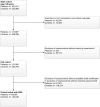Risk of infections in patients with gout: a population-based cohort study
- PMID: 28469154
- PMCID: PMC5431148
- DOI: 10.1038/s41598-017-01588-5
Risk of infections in patients with gout: a population-based cohort study
Abstract
To investigate the risk of various types of infections (pneumonia and urinary tract infection (UTI)), and infection-related mortality in patients with gout compared with population-based controls. A retrospective cohort study was conducted using data from the UK Clinical Practice Research Datalink (CPRD). All patients with a first diagnosis of gout and aged >40 years between January 1987-July 2014, were included and matched with up to two controls. Time-varying Cox proportional hazards models were used to estimate the risk of infections and mortality. 131,565 patients and 252,763 controls (mean age: 64 years, 74% males, mean follow-up of 6.7 years) were included in the full cohort. After full statistical adjustment, the risk of pneumonia was increased (adj. HR 1.27, 95% CI 1.18 to 1.36), while the risk of UTI (adj. HR 0.99, 95% CI 0.97 to 1.01) was similar in patients compared to controls. No differences between patients and controls were observed for infection-related mortality due to pneumonia (adj. HR 1.03, 95% CI 0.93 to 1.14) or UTI (adj. HR 1.16, 95% CI 0.98 to 1.37). In conclusion, patients with gout did not have decreased risks of pneumonia, UTI or infection-related mortality compared to population-based controls.
Conflict of interest statement
The authors declare that they have no competing interests.
Comment in
-
Bringt Gicht dem Immunsystem Power?MMW Fortschr Med. 2018 Feb;160(3):36. doi: 10.1007/s15006-018-0195-8. MMW Fortschr Med. 2018. PMID: 29464624 German. No abstract available.
Similar articles
-
Association of Fluoroquinolones With the Risk of Aortic Aneurysm or Aortic Dissection.JAMA Intern Med. 2020 Dec 1;180(12):1596-1605. doi: 10.1001/jamainternmed.2020.4199. JAMA Intern Med. 2020. PMID: 32897307 Free PMC article.
-
Gout and incidence of 12 cardiovascular diseases: a case-control study including 152 663 individuals with gout and 709 981 matched controls.Lancet Rheumatol. 2024 Mar;6(3):e156-e167. doi: 10.1016/S2665-9913(23)00338-7. Lancet Rheumatol. 2024. PMID: 38383089
-
Serious Infections in Patients With Gout in the US: A National Study of Incidence, Time Trends, and Outcomes.Arthritis Care Res (Hoboken). 2021 Jun;73(6):898-908. doi: 10.1002/acr.24201. Arthritis Care Res (Hoboken). 2021. PMID: 32248660
-
Risk Factors for Urinary Tract Infection or Pneumonia After Admission for Traumatic Subdural Hematoma at a Level I Trauma Center: Large Single-Institution Series.World Neurosurg. 2020 Feb;134:e754-e760. doi: 10.1016/j.wneu.2019.10.192. Epub 2019 Nov 9. World Neurosurg. 2020. PMID: 31712113
-
Association of Postoperative Infection With Risk of Long-term Infection and Mortality.JAMA Surg. 2020 Jan 1;155(1):61-68. doi: 10.1001/jamasurg.2019.4539. JAMA Surg. 2020. PMID: 31693076 Free PMC article.
Cited by
-
Relationship between hyperuricemia with deposition and sexual dysfunction in males and females.J Endocrinol Invest. 2022 Apr;45(4):691-703. doi: 10.1007/s40618-021-01719-w. Epub 2022 Jan 8. J Endocrinol Invest. 2022. PMID: 34997558 Free PMC article. Review.
-
A 55-Year-Old Male With Systemic Gout Complicated by Septic Shock.Cureus. 2023 Jun 21;15(6):e40764. doi: 10.7759/cureus.40764. eCollection 2023 Jun. Cureus. 2023. PMID: 37485089 Free PMC article.
-
Comorbidities and their impact on in-hospital mortality in hospitalized adult patients with bacterial community-acquired pneumonia: a cohort study.J Thorac Dis. 2025 Jul 31;17(7):4909-4928. doi: 10.21037/jtd-2024-2081. Epub 2025 Jul 28. J Thorac Dis. 2025. PMID: 40809266 Free PMC article.
-
The Association Between Usage of Colchicine and Pneumonia: A Nationwide, Population-Based Cohort Study.Front Pharmacol. 2019 Aug 16;10:908. doi: 10.3389/fphar.2019.00908. eCollection 2019. Front Pharmacol. 2019. PMID: 31474864 Free PMC article.
-
Cause-Specific Mortality in Gout: Novel Findings of Elevated Risk of Non-Cardiovascular-Related Deaths.Arthritis Rheumatol. 2019 Nov;71(11):1935-1942. doi: 10.1002/art.41008. Epub 2019 Sep 25. Arthritis Rheumatol. 2019. PMID: 31169353 Free PMC article.
References
MeSH terms
LinkOut - more resources
Full Text Sources
Other Literature Sources
Medical


